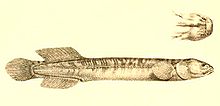Neochanna
| Neochanna | |
|---|---|
 |
|
| Brown mudfish, Neochanna apoda | |
| Scientific classification | |
| Kingdom: | Animalia |
| Phylum: | Chordata |
| Class: | Actinopterygii |
| Order: | Osmeriformes |
| Family: | Galaxiidae |
| Genus: |
Neochanna Günther, 1867 |
| species | |
|
See text. |
|
See text.
Neochanna is a genus of galaxiid fishes, commonly known as mudfish, which are native to New Zealand and south-eastern Australia.
The recognized species in this genus are:
Mudfishes are small, growing to a maximum of 180 mm (7.1 in). They have a tubular, highly flexible, scaleless body with rounded fins, well-developed flanges on the caudal peduncle, tubular nostrils, small or absent pelvic fins, and mottled brown colouration. Adults are active at night and are usually found in the benthic zone, while juveniles are active during the day and are found in open water.
Mudfishes are found in wetlands, swamps, drains and springs. They typically live in still or slowly flowing, shallow water, with thick aquatic vegetation and overhead cover.
Mudfish have the ability to aestivate during droughts, seeking out moist areas under logs and vegetation so they do not dry out. While emersed (out of the water), they respire through cutaneous respiration, either through their skin, or by taking mouthfuls of air. Emersed mudfish frequently lie on their backs, possibly improving cutaneous respiration through the thinner abdominal skin, improving oxygenation of vital organs, or rehydrating skin on their upper surfaces.
As wetland habitats dry out, the standing water may become stagnant and hypoxic. During this time mudfish will hang quietly at the surface with bubbles of air in their mouths to improve oxygen absorption. Some choose to leave hypoxic water before it dries out, and leave again if pushed back in.
While emersed they are aware of their surroundings and are responsive to change in their environment: changing position, moving to damper areas, and congregating. Although they may be found deep below the surface in cavities and root holes, they do not appear to create burrows for the purpose of aestivation, with the exception of N. cleaveri. Under experimental drought conditions, N. cleaveri created vertical shafts in the mud substrate, which allowed the fish to remain submersed as the free water evaporated. As the water within the shaft evaporated, the mudfish excavated horizontal tunnels where they awaited the return of the water. They do not feed while emersed, but may return to water at night to feed.
...
Wikipedia
